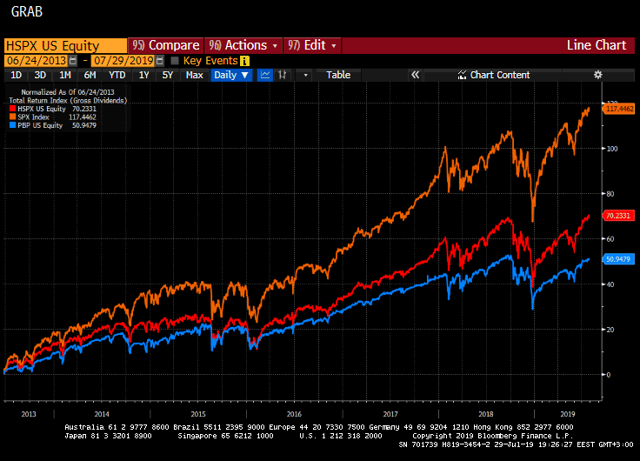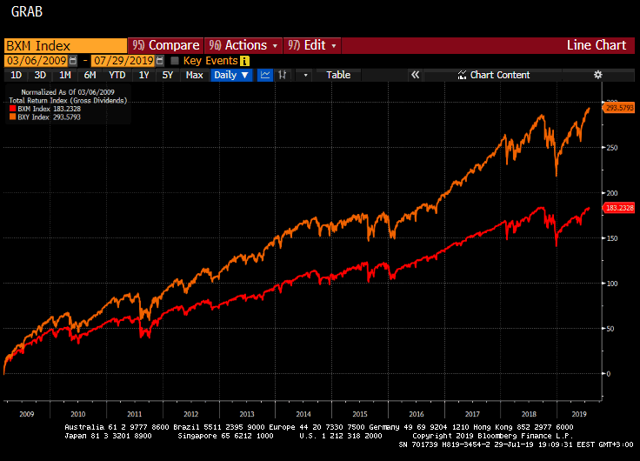[ad_1]
Editor’s note: Seeking Alpha is proud to welcome Grigoris Vlassis as a new contributor. It’s easy to become a Seeking Alpha contributor and earn money for your best investment ideas. Active contributors also get free access to SA Essential. Click here to find out more »
The S&P has been hovering around all-time highs while the central banks worldwide are on the verge of a new round of monetary easing, in what seems like a coordinated effort to boost the economy. The combination of GDP growth and a dovish Fed is the ideal condition for another run-up of the US equity markets. However, there are still issues in terms of the economic and political landscape that contradict this view. USA and China have failed to reach an agreement so far in the trade talks, and it is doubtful that the negotiations will produce any concrete results quickly enough to calm the markets. Additionally, the US economy has shown signs of slowing, as it is drugged down by the sluggish growth overseas, especially in Europe. Moreover, we are now officially in the longest economic expansion in history, and this fact alone raises concerns over whether the end of this cycle is right around the corner.
Is it the right time to consider covered calls now?
Under the circumstances described above, a covered call strategy seems like the appropriate course of action for an investor who still wants exposure to the markets, while concurrently remaining partially hedged, in case of a pullback. A covered call is an options-based strategy that allows investors to earn income via the premium received for writing the option. The underlying index is bought – in our case, the S&P 500 – and a call option is written on the index. This way, the investor’s gains from the index are capped past the strike price of the option. On the other hand, if the S&P 500 ends up lower than the strike price, the investor collects the option premium and mitigates losses, if any, from the index.
In general, selling call options on the S&P is not an idea that I recommend, even in times when I have a bearish view of the market. The implied volatility of the calls is relatively lower due to “volatility skew”, a phenomenon in the options curve structure. Practically, this means that the calls trade at a relative discount compared to the put options, putting the seller of the calls at a relative disadvantage. However, in the current market environment and after 10 years of extraordinary equity returns, a more cautious approach is advisable.
The easiest way to pursue such a strategy is through ETFs and specifically the Invesco S&P 500 BuyWrite Portfolio (PBP) and the Global X S&P 500 Covered Call ETF (HSPX). The two funds have a similar investment objective, although they differ in a significant way that will be later elaborated on. Both ETFs invest in securities of the S&P 500 and sell call options on the index. HSPX pays dividends monthly – PBP does it quarterly – which is an aspect that may appeal to income seekers. On the flip side, PBP has much higher liquidity, almost three times the daily volume of HSPX and a lower expense ratio (0.49% vs. 0.65%).
Predictably, both funds have underperformed the S&P 500 in this bull market, as the calls sold throughout this period have trimmed the gains from the index. Since 2013 when both ETFs have been available, the S&P has a total return of 117%, HSPX 70%, and PBP 51% But why has HSPX performed significantly better than PBP?
S&P, HSPX, PBP Total Returns Since 06/24/2013

Source: Bloomberg Terminal
HSPX or PBP? It depends on how much defense you want to play…
The two funds have an almost identical portfolio of equities, so the answer lies in the choice of the call options that the funds sell to execute their strategy. PBP replicates the CBOE S&P 500 BuyWrite Index while the HSPX has the CNOE S&P 500 2% OTM Buy-Write Index as its benchmark. Every month, PBP sells the at-the-money call options on the S&P, while HSPX sells 2% out-of-the-money calls (maturity for both is 30 days to expiration). The S&P’s Friday 8/2/2019 close was at 2,930. In a hypothetical case, where the two funds would sell the option right before the close, PBP would sell the 2,930 call, while HSPX would sell the 2,990, which is 2% above the current levels of the index. Even though HSPX collects a cheaper premium, the call has a higher chance of ending up out of the money, in which case the investor collects the whole premium. This explains the underperformance of PBP as compared to HSPX during bull markets, as the at-the-money calls sold did greater damage than the out-of-the-money ones.
BMX, BMY Since 03/06/2009 (S&P Lows)

Source: Bloomberg Terminal
Conclusion
I continue to be optimistic about the prospects of the US equity markets going forward, despite the red flags and the uncertainty over the economy. However, I do expect that the next couple of years will produce somewhat moderate returns as compared to the last decade, and this makes me think of a covered call ETF as the optimal idea. I favor HSPX over PBP, as it is less defensive relative to PBP, while providing a good hedge in the case of a market that moves sideways or even mildly lower. It is important to point out that if we see a significant correction, the hedge provided by both ETFs will do very little to mitigate the losses from the exposure to equities.
Disclosure: I/we have no positions in any stocks mentioned, and no plans to initiate any positions within the next 72 hours. I wrote this article myself, and it expresses my own opinions. I am not receiving compensation for it (other than from Seeking Alpha). I have no business relationship with any company whose stock is mentioned in this article.
[ad_2]
Source link Google News

